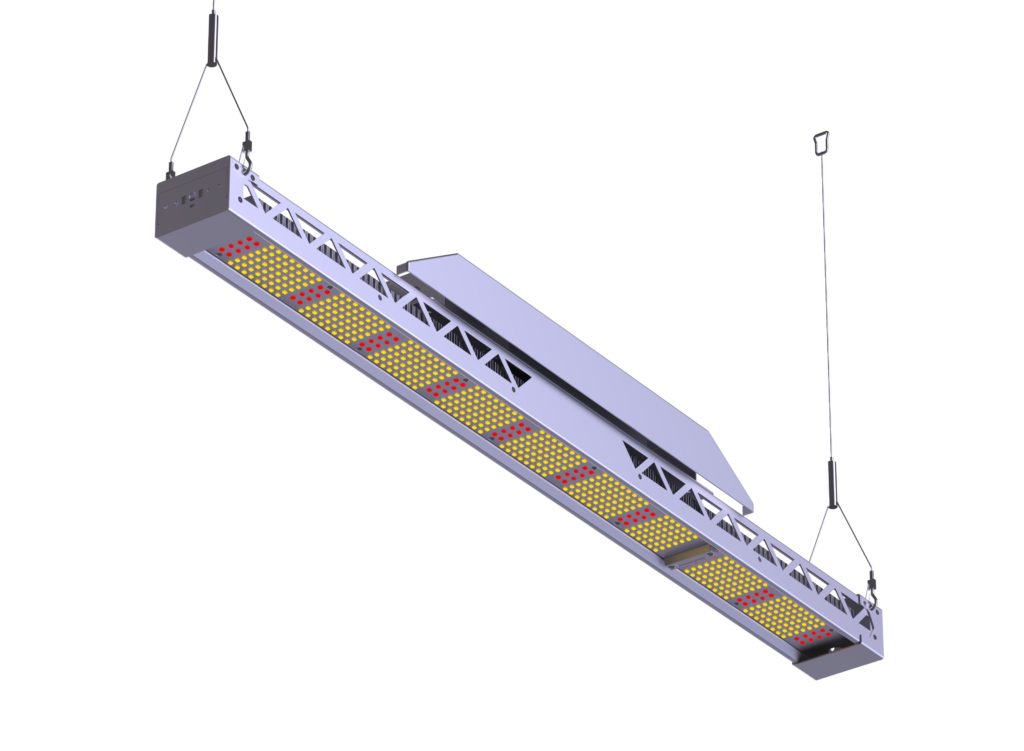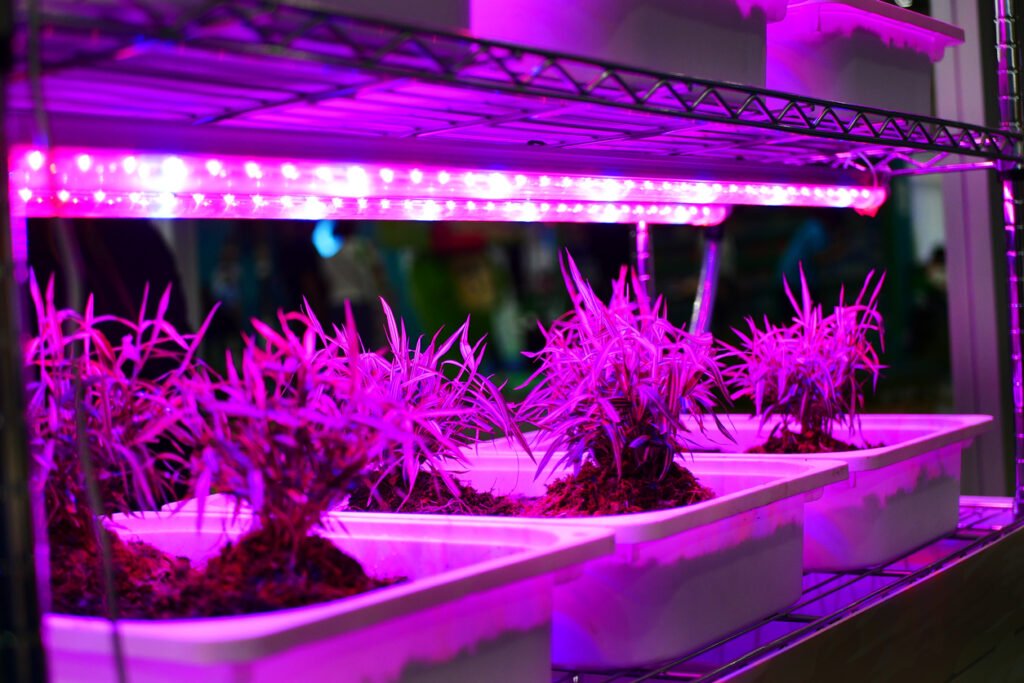Under the control of the epidemic, “it is difficult to buy food” has become the focus, but the field of LED lighting has become more popular.
Recently, the epidemic in Shanghai, Shenzhen, Guangzhou, Dongguan, and other places has been affecting people, and under the prevention and control of the epidemic, “buying vegetables” has become the focus of the epidemic control, and green vegetables have become a “luxury” in everyone’s eyes.
In the past two years, home quarantine caused by the epidemic has almost become the norm, and the resulting shortage of household vegetable supply has also stimulated people’s strong interest in growing their vegetables. In addition, the United States MORE Act plans to legalize industrial marijuana, and with the food crisis caused by the COVID-19 epidemic, LED plant lighting will have a great chance to enter the city and enter the family. Many manufacturers began to increase the layout in the plant lighting industry.
In the home isolation zone, vegetables are inevitably difficult to find. However, is the plant growth lamp produced by the company suitable for urban agriculture such as growing vegetables and growing flowers and plants indoors?
The answer is yes. As we all know, in an environment where there is a lack of sunlight, this kind of lamp can act as sunlight, so that plants can grow normally or better. And has a strong root, promotes, regulates flowering, and flower color, promotes fruit ripening, and color, and improves the taste and quality of the role!
With the development and change of lighting technology and the innovation of artificial light sources, the energy consumption of plant lamps has been reduced. LED plant lighting is entering cities and families, combining with communities, supermarkets, families, hotels, restaurants, hospitals, pensions, school science popularization, and so on. It is widely used in plant tissue culture, plant factories, algae culture, flower cultivation, vertical farm, commercial greenhouse, marijuana cultivation, and other fields.
If you want to grow vegetables during this period, you might as well learn about LED plant lighting first!

What is grow light?
Plant lighting refers to the use of an artificial light environment instead of sunlight to ensure the healthy growth of plants. Compared with the sun, the biggest advantage of plant lighting is its controllability, which can provide stable and consistent light for plants, and will not change its lighting intensity with the change of time and weather.
The light environment is one of the indispensable important physical environment factors for plant growth and development. Controlling plant morphology through light quality regulation is an important technology in the field of facility cultivation, and plant growth lamp plays a more important role in environmental protection and energy-saving.
The effect of LED lamps on grows light.
LED plant lights to provide plants with photosynthesis, promote plant growth, shorten the time it takes for plants to blossom and bear fruit, and improve production! In the modernization drive, it is an indispensable product of crops.
Characteristics of led grow light:
1. Rich in types, which coincides with the spectral range of plant photosynthesis and photomorphogenesis.
2. the width of the spectral wave is half-width and narrow, and the pure monochromatic light and composite spectrum can be obtained according to the need, and the crop can be evenly irradiated with light of a specific wavelength.
3. It can not only regulate the flowering and fruiting of crops, but also control the plant height and plant nutrition; the system has less heat and takes up less space, so it can be used in the three-dimensional combination system of multi-layer cultivation, realizing low heat load and miniaturization of production space.
4. The production cycle has more than doubled. According to Yang Qichang, chief scientist of the Intelligent Plant Factory of the Chinese Academy of Agricultural Sciences, lettuce generally takes 70 days to grow, while the plant factory only needs 21-25 days, and the planting time is 1/3 of the natural one.
5. save the occupied area, in the process of production, the plant factory can build more than ten floors, and the production capacity of the same land area is more than 40Mel 100 times of the open field area.
Measuring the wavelength of grow light.
LED plant lamp helps to shorten the plant growth cycle, because the light source of this lamp is mainly composed of red and blue light sources, using the most sensitive light bands of plants, red light wavelengths use 620-630nm and 640-660nm, blue light wavelengths use 450-460nm and 460-470nm. These light sources make plants produce the best photosynthesis and get the best growth state. experiments and practical applications show that in addition to replenishing light in the lack of light, plants also promote the differentiation of multiple lateral branches and buds in the process of growth, accelerate the growth of roots, stems, and leaves, accelerate the synthesis of plant carbohydrates and vitamins, and shorten the growth cycle.
With the rapid increase in global demand for organic food, the development of organic cultivation is an opportunity for more and more producers.
Several studies have shown this.
1. Study on LED as supplementary lighting for plant photosynthesis.
Traditional artificial light sources generate too much heat, such as using LED supplementary lighting and hydroponic systems, air can be recycled, excess heat and water can be removed, and electrical energy can be efficiently converted into effective photosynthetic radiation and eventually into plant matter. The results show that using LED lighting, the growth rate and photosynthetic rate of lettuce are increased by more than 20%, and it is feasible to use LED in plant factories.
It was found that compared with a fluorescent lamp, mixed wavelength LED light could significantly promote the growth and development of spinach, radish, and lettuce, improve the morphological index, maximize the bioaccumulation of beet, the most significant accumulation of betaine in the hairy root, and produce the highest accumulation of sugar and starch in the hairy root.
Compared with metal halide lamps, the anatomical morphology of stems and leaves of pepper and perilla plants grown at the same wavelength LED changed significantly, and the photosynthetic rate of plants increased with the increase of light density. Compound wavelength LED can increase the number of stomata in marigold and sage plants.
2. LED is used as the induced illumination of photoperiod and photomorphogenesis in plants.
The specific wavelength of LED can affect the flowering time, quality, and flowering duration of plants. Some wavelengths of LED can increase the number of flower buds and flowers, while some wavelengths of LED can reduce the reaction of flowering, and regulate the length of pedicel and fluorescence, which is beneficial to the production and listing of cut flowers. Thus it can be seen that the flowering and subsequent growth of plants can be regulated by LED regulation.

3. Study on the application of LED in aerospace ecological life support system.
The establishment of a controlled ecological life support system (Controlled Ecological Life Support System, CELSS) is the fundamental way to solve the problem of long-term manned space life support. The cultivation of higher plants is an important component of CELSS, and one of the keys is light.
Based on the special requirements of the space environment, the light source used in space for higher plant cultivation must have the characteristics of high luminous efficiency, output lightwave suitable for plant photosynthesis and morphogenesis, small size, lightweight, long life, high safety, and reliability record and no environmental pollution.
Compared with other light sources such as a cold white fluorescent lamp, high-pressure sodium lamp, and metal halogen lamp, LED can convert light energy into photosynthetically active radiation more effectively. In addition, it has the characteristics of long life, small volume, lightweight and solid-state.
Therefore, more and more attention has been paid to plant cultivation on the ground and in space in recent years. Studies have shown that LED lighting systems can provide lighting with uniform spectral energy distribution, and the efficiency of converting electrical energy into light needed by plants is 520 times higher than that of metal halide lamps.
All in all, from the perspective of global regional market demand, in the short term, plant lighting market demand mainly comes from overseas markets, but with the improvement of LED light efficiency, the cost continues to decline, and domestic and local policy support for digital and modern agriculture has set off wave after wave of upsurge around the world. In the future, the LED plant lighting scheme will play an important role in solving the impact of limited land resources and unstable climate on agriculture and harvest stability. The domestic plant lighting market is showing full vitality and has become a new niche for the development of domestic enterprises.
For more info welcome to visit our company website: www.enetcl.com.




